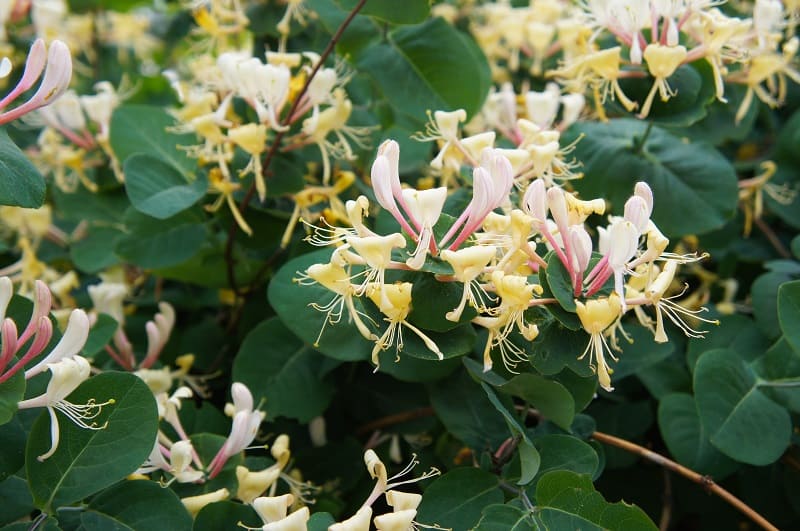
If your honeysuckle plant is dying, it means that there is an environmental factor causing it stress. This could be underwatering, insufficient sunlight, lack of nutrients in the soil, or disease.
To save your dying honeysuckle, you need to correctly diagnose the cause of the symptoms so that you can solve the problem as soon as possible.
In this article, we will discuss the possible reasons your honeysuckle is dying, and how to save it.
Why is my honeysuckle plant dying?
Underwatering
If you notice that your honeysuckle’s leaves are turning yellow and also dropping a lot more than usual, it is most likely due to underwatering or drought. The soil in the plant’s pot has been dry for so long that the plant has lost most of its moisture.
The honeysuckle’s natural habitat is the rich soil of the woodlands. It is used in the soil that is moist and full of nutrients, which is why it is sensitive to a lack of water. In nature, the ground around the honeysuckle is full of decomposing leaves, which help to keep moisture in the soil and also ensure it is well-draining.
When the plant is in your garden, it can become underwatered for a number of reasons. One of these is that the base of the plant may be directly under the sun, which will result in the soil drying out too quickly. Another reason could be that your garden soil is too stony or sandy, making it a little too well-draining. If the soil does not retain moisture well enough, the plant cannot absorb water and nutrients fast enough to store them. Finally, another cause of underwatering is planting the honeysuckle too close to a fence or a wall. When the rain falls, the fence or wall may block the water from reaching the plant.
Save your underwatered honeysuckle by placing mulch around the base of the plant. By adding mulch, you simulate the ground in the plant’s natural habitat, which has plenty of environmental litter that conserves moisture around the plant’s base. An inch of mulch should be enough also to improve the soil’s structure and add nutrients.
Water the honeysuckle with a generous soak once a week during spring and summer, so that it does not become underwatered and to help the plant establish its roots better. Stronger and more established roots will be better at resisting drought.
Add mulch to the base of the plant every six months and your plant should thrive.
Insufficient sunlight
Honeysuckles need to be in an area where their vines get plenty of sunlight while the roots are kept mostly shaded. The sunlight is important to encourage blooming, while the shade on the base of the plant ensures the soil does not dry out too quickly after watering.
You shouldn’t need to worry too much about the plant getting sun, since its vines are able to grow in the direction of the sun.
However, if the plant is unable to get the sunlight it needs, this can lead to the yellowing of the leaves and leaf defoliation. This is especially apparent when the top part of the plant looks healthy while the lower half is yellowing, because only the upper half is able to reach the sun. The leaves in the lower half of the plant will eventually drop off.
If your honeysuckle’s sunlight is getting blocked by trees or other plants, you can cut some branches off the surrounding plants to give it more much-needed sunlight. Never allow the honeysuckle to stay in full shade, or it may not live for very long.
Lack of nutrients
As mentioned above, the honeysuckle’s natural habitat is woodlands, where the soil is rich in organic matter from the decomposing leaves and other nutrient-rich material.
When the plant is grown in a garden or a pot where the soil is poor, the plant will not flower, and its leaves will turn yellow and drop off.
Your soil may be lacking nutrients because they become depleted over time, especially in a container with a limited volume of soil. If you do not fertilize or mulch the soil every year, the soil cannot remain healthy and the plant will die back.
You can save undernourished honeysuckle by simulating the soil conditions of their natural habitat, by adding mulch to the base of the plant. Do this every year to replenish the nutrients in the soil and to keep the soil moist for longer.
Place one inch of leaf mold or compost on the base of the plant in the spring, and again in the summer.
Disease
The disease is another common reason your honeysuckle may be dying. If you see white or gray mold with black spots on the plant’s leaves, it may have powdery mildew.
This can be resolved, but the recovery time will depend on how early you are able to catch the disease and start treatment.
Risk factors for powdery mildew include poor soil, high humidity, insufficient sun, too much fertilizer, and underwatering.
Treat powdery mildew by removing the infected foliage using a sterile pair of scissors. You need to disinfect the blades of the scissors between each cut so that you do not transfer spores to the healthy foliage. If there is any debris, collect this and discard it properly so that it does not infect other healthy plants. You can also use neem oil or fungicide to get rid of powdery mildew on the leaves.
Conclusion
If your honeysuckle plant is dying, it means there is an environmental factor causing the plant stress. Saving the plant begins with correctly diagnosing the cause of the plant’s declining health.
The most common causes of a dying honeysuckle plant are underwatering, overwatering, insufficient sunlight, lack of nutrients in the soil, or disease.
Image: istockphoto.com / Liudmyla Liudmyla